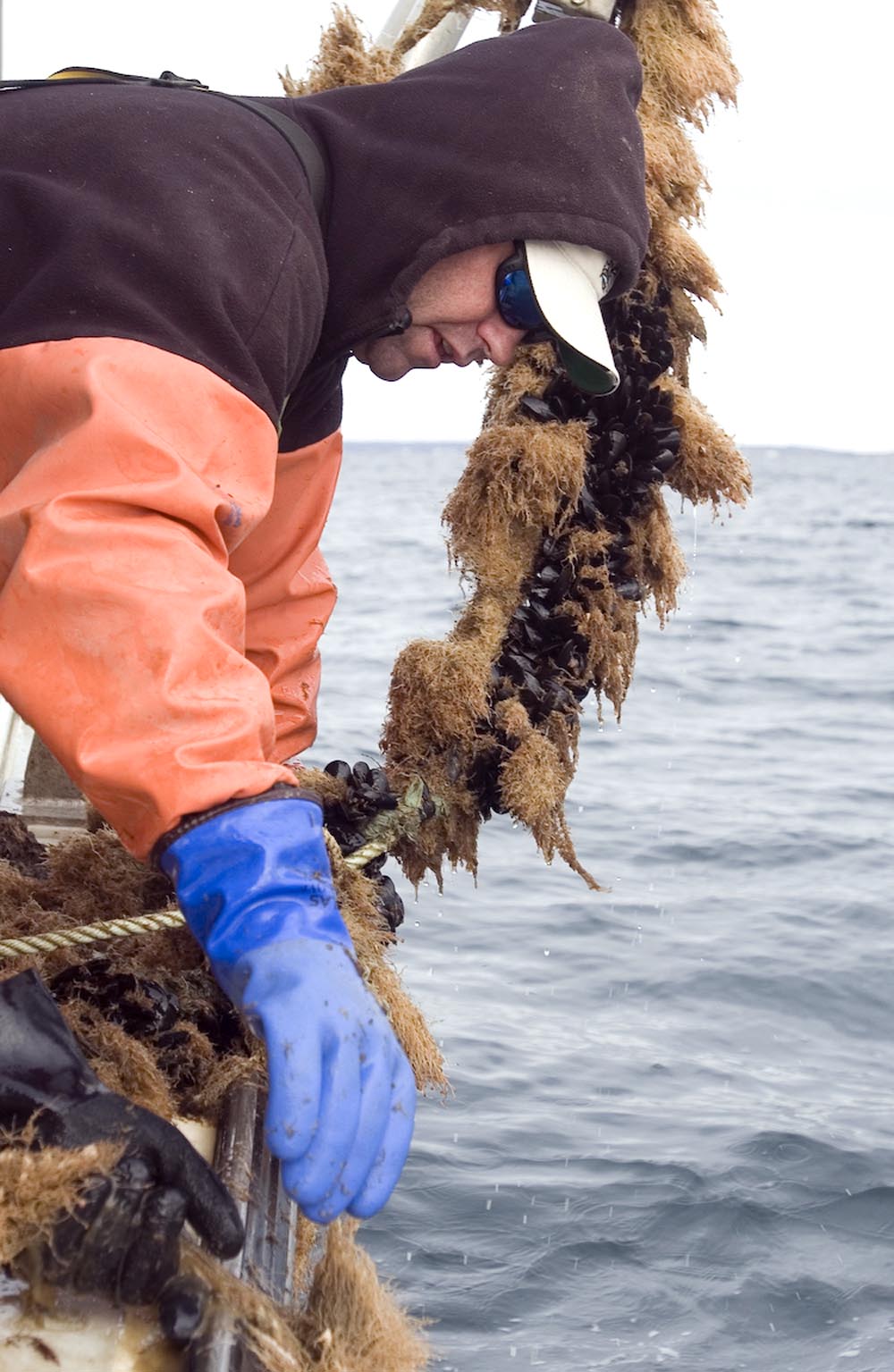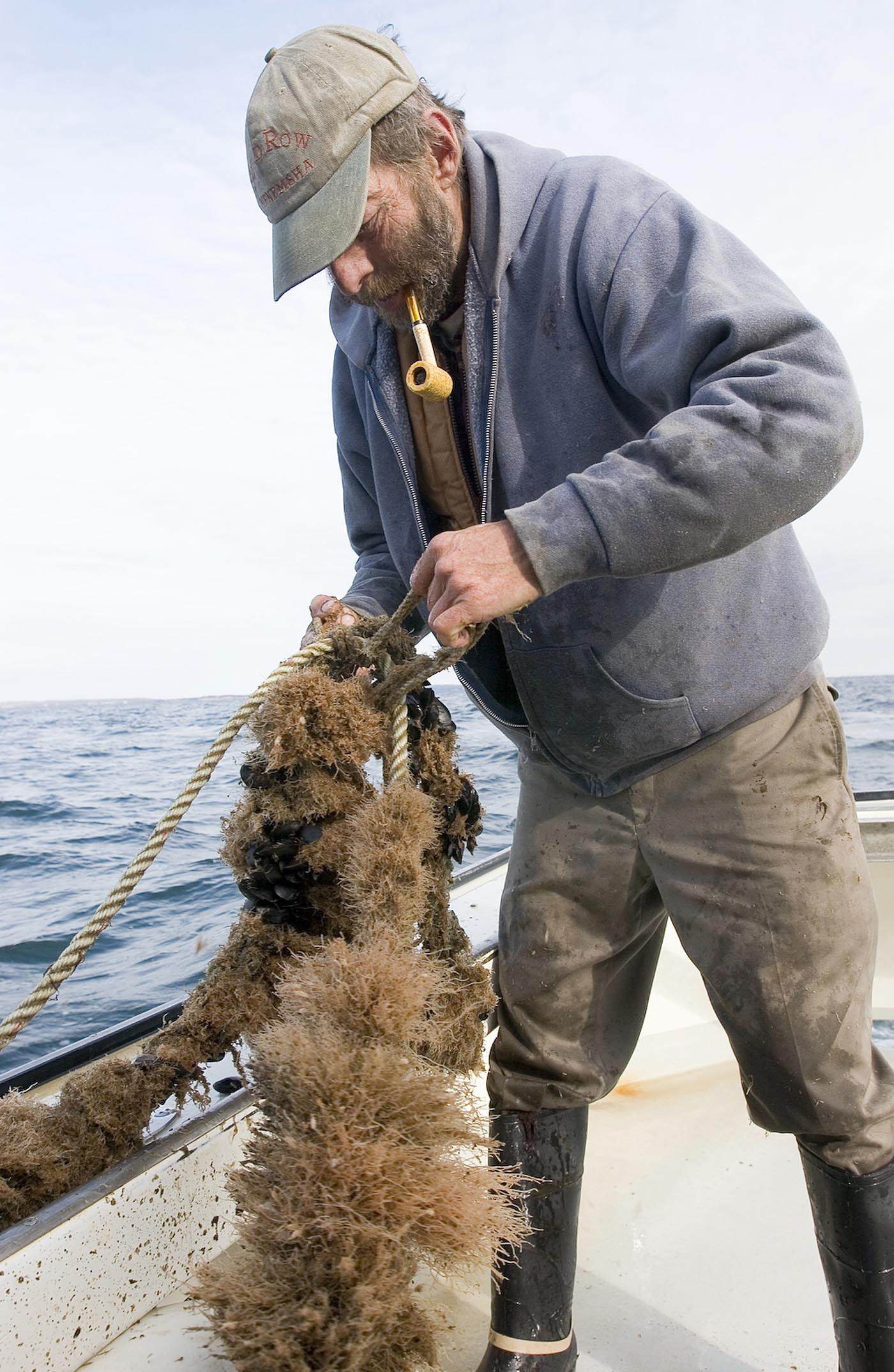On this November morning, the Menemsha lobster boat Shearwater has made its way three and a half miles south of Noman’s Land.
Noman’s tall cliffs rise above the treacherous rocky waters. Sea birds are adrift in the moving current farther north.
Waves roll from the open ocean and raise and lower the boat in a gentle fashion, like a mother rocking a sleeping child. The sky is blue and metallic; the color of the sea beneath is a darker version of the sky. A gentle cold breeze freshens. The bow points towards Spain.
After hooking a floating buoy, Capt. Paul McDonald pulls a line aboard that isn’t connected to a lobster pot. There is uncertainty as to what will come out of the water.
A long bead of salt water shoots off the line as it comes aboard the vessel. The seaweed-covered line speeds through a hydraulic winch.
In an instant, the incoming line changes from a strand of rope to a thick six-foot-length snake made up of hundreds of juvenile blue mussels. The rope holding it all together is obscured from view by the shellfish and marine growth.
All aboard the Shearwater are visibly ecstatic.
Tom Osmers, the West Tisbury shellfish constable and commercial fisherman, grabs the mussel-packed line and passes it over to Rick Karney, director of the Martha’s Vineyard Shellfish Group, for his examination.
“This is the fun part,” Mr. Karney said.
Amandine Surier, who also works at the shellfish group, holds a video camera. She points her lens at the marine mass of creatures connected to the line, which includes sand fleas and tiny shrimp. Mr. Karney collects samples from the rope and puts them in numbered plastic bags for future examination.
The mussel-covered line — part of a scientific study into whether blue mussels can be raised in Vineyard waters — may be the precursor to a flourishing new Island fishery.
The early results are promising. Researchers say the Vineyard blue mussels may reach maturity in 12 months, faster than blue mussels already being raised off the coast of New Hampshire.
Further, the pea crab, a creature that has invaded the New Hampshire mussels, has barely been found among the Vineyard blue mussels.
And the blue mussels in Vineyard waters also may be more tolerant of warmer temperatures than the mussels farther north. That’s a key point, since mussels will release themselves from a line should they find the water too warm.
While fishermen have known for generations that blue mussels naturally reside in these waters, few have ever capitalized on the opportunity.
The project to explore the possibility of raising blue mussels in these waters was launched last winter by a group of Chilmark fishermen seeking to find ways to ensure that Menemsha remains a viable fishermen’s port. The Chilmark and West Tisbury selectmen sanctioned the blue-mussel project, which drew the attention of more than a dozen commercial fishermen.
Stanley Larsen, Chilmark’s shellfish constable and owner of a fish market, suggested the idea. With the help of Mr. Karney, Richard Langan, a director of the University of New Hampshire’s Cooperative Institute of New England Mariculture and Fisheries, an expert on blue mussel farming was brought down from New Hampshire, came and talked about his successful program of raising blue mussels in the waters of Isle of Shoals.
Mr. Langan’s talk at the Chilmark Public Library sparked interest.
Last spring, Mr. Karney was able to get funding for the establishment of three experimental stations in Vineyard waters. The purpose was to see if blue mussels could be raised on rope lines, following Mr. Langan’s suggestions.
The project received $4,000 from the Massachusetts Department of Agricultural Resources, $5,000 from the Martha’s Vineyard Permanent Endowment Fund and support from Mr. Langan, Marine Biological Laboratory and the newly created Menemsha Fisheries Development Fund.
Project participants set up three stations: one south of Noman’s and two off the Vineyard’s north shore. They acquired baby blue mussels from Emmett Carroll, a Chilmark lobsterman and oyster farmer, and attached the little bivalves to the lines with the use of biodegradable socks.
Though the socks have long since disappeared, the vibrant blue mussels remain.
An hour after the visit to the Noman’s station, the Shearwater is off the Vineyard’s north shore visiting two additional stations. In the waters just off Seven Gates, the blue mussel experimental station is even more densely packed with shellfish. At the third and last station, off Cedar Tree Neck, the rope is an equal match compared to the first.
Scientific results from the three stations is promising.
This week Mr. Karney got news back from Scott Lindell, a scientist with the Marine Biological Laboratory in Woods Hole, who evaluated 80 blue mussels and looked for evidence of the tiny pea crab. Only one mussel was found to have a pea crab.
“That is a really impressive result,” Mr. Karney said. Pea crabs are tiny little creatures that find their way inside the blue mussel. If found in adult blue mussels, the crabs lower the marketability of the shellfish. They’re not harmful to humans, but diners don’t welcome discovering them inside their mussels.
With so much good news, Mr. Karney said the next step will be to see whether there is an Island commercial fisherman willing to pursue raising blue mussels. A governmental permit process could take anywhere from six months to a year to complete. Mr. Karney said he will help any fishermen interested in taking those big steps.
“There is a procedure,” he said. “They’ll first have to go before the selectmen to request a lease. The next step will be the state Division of Marine Fisheries. I suspect it won’t be too much of an issue offshore. They’ll have to get an approval from the Army Corp of Engineers. There are probably navigation issues and whale entanglement issues.”
In the meantime, Mr. Karney and others will continue to monitor the blue mussels at the three stations to see how long it takes them to reach adult harvestable size and whether the pea crab makes an appearance. The project also is seeking an additional grant from the National Marine Fisheries Service.









Comments
Comment policy »